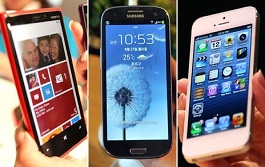Smartphone customers are consuming more data on a per-user basis than tablet users, according to a new report, which is helping to push mobile networks towards a spectrum crunch.
The fourth-annual study from network solutions firm JDSU found that out of the top 10 most data-intensive devices six were smartphones, three were tablets and one was a phablet.
The research was conducted in collaboration with operators in various developed and developing markets.
It found that users of Apple’s iPhone 5 consume more downlink data than any other smartphone user, while the HTC Sensation XL generated the most signaling traffic per user of any device.
The “extreme one percent” of all users consume over half of the UMTS downlink data in both developing and developed markets.
Meanwhile, 4G LTE users are 10-times “more extreme” than those without the next gen service, and just 0.1 percent of all users consume over half of the LTE downlink data.
Dr. Michael Flanagan, CTO of Mobility for the Network and Service Enablement business segment of JDSUand author of the report, told Mobile Europe that operators are heading towards a spectrum crunch as a result.
“We are reaching boiling point – operators just don’t have enough spectrum to cope up with this massive increase,” he said.
Mobile infrastructure will overload “at some point” and operators will face some “ugly” choices, Flannigan believes.
He added: “[Operators] could say goodbye to their heavy data users, which can be a good thing because that would mean they go to a competitor to crucify their network and a lot of your network capacity becomes liberated.
“Or, operators might look at these users as valuable customers, decide to keep them and upgrade their infrastructure to LTE and small cells.”
The CTO said that operators that deploy small cells should do so in a “surgical and targeted” way in areas where their heaviest users reside.
Mobile operators have several other ways in which they can mitigate the risks of congestion, such as offloading traffic onto the fixed networks via Wi-Fi, using web and content optimisation techniques to reduce traffic volumes and management of subscriber usage patterns via new pricing models.
Meanwhile regulators, such as Ofcom in the UK, are looking at ways to boost the capacity of mobile broadband by adding new spectrum bands and refarming old ones.
Whatever happens, Flanagan thinks a spectrum crunch will be inevitable.
“Its unavoidable, the problem with spectrum is that the reform at which it occurs is extremely slow, it’s not keeping up with the rate at which mobile demand continues to increase. We need 50 percent more spectrum year-on-year to address the current data growth, which, simply isn’t possible,” he concluded.
The Arieso report chimes with an October 2013 Deloitte study that found in the seven years it has taken to develop and deploy 4G LTE, wireless traffic has increased 30-fold.
“Vendors simple cannot invent new technologies fast enough to meet growing demand,” it said in its Looming Spectrum Shortage report.
Read more


